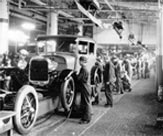Ford Employees talk about What It Takes To Build A Quality Vehicle.
Importance of Manufacturing to the U.S. Economy
Re-Shaping Our Industry
The last several years have been tumultuous for the automotive industry in the United States, even by the standards of a sector that has seen more than its share of ups and downs. The challenges that the industry has faced in the last several years have reshaped it irrevocably and surrounded it with new realities and challenges.
Ten years into the 21st century, the American auto industry finds itself in a new competitive framework, with opportunities to strengthen its role as a catalyst for a new competitiveness in American manufacturing. Ford is set to seize these opportunities as it looks to deliver profitable growth within the industry’s vastly reshaped landscape.
The health of the U.S. manufacturing sector is critical to the country’s long-term economic prosperity. A globally competitive manufacturing sector creates a stable economic foundation that encourages domestic and foreign investment. The automotive industry, in particular, is critical to the health of the U.S. economy; no other single industry is so closely identified with U.S. manufacturing or directly generates as much retail business and overall employment. A healthy and competitive automotive industry creates good jobs and builds strong communities. It fosters innovation, helps drive growth and creates demand for highly skilled workers.
Over the past six years, automakers and suppliers have exported vehicles and parts valued at nearly $600 billion. In fact, the auto industry topped exports from the next best performing sector, aerospace, by $74 billion. In addition, as America’s top exporter, the auto industry is a critical engine for R&D spending, outspending software and electronics manufactures by more than $30 billion annually.(1)
One of the most profound shifts in the structure of the U.S. auto industry in the last decade has been the essential eradication of the “Big Three” label and a focus on a wider set of automakers who are consistently strengthening their presence in the United States. While the three domestic manufacturers loom large in the industry, manufacturers from Asia and Europe have come into the United States and are now competing with American workers and capturing a significant segment of the buying public. By 2010, the market share in the U.S. for Ford, GM and Chrysler equaled about 44.5 percent – with the balance going to transplant manufactures like Toyota, Honda, Hyundai, Volkswagen and others.
Apart from the visible changes in the automobile market, there are very specific economic imperatives that need to be met in order to truly compete at a profitable level. Chief among them: The ability to design and build vehicles that consumers want to buy – and to do that at a price that will sustain the jobs on which the industry depends. U.S. automakers can design the greatest cars in the world, but without a skilled workforce that is competitive with foreign companies building cars in their backyard, the domestic automakers are doomed to repeat the mistakes of the past.











